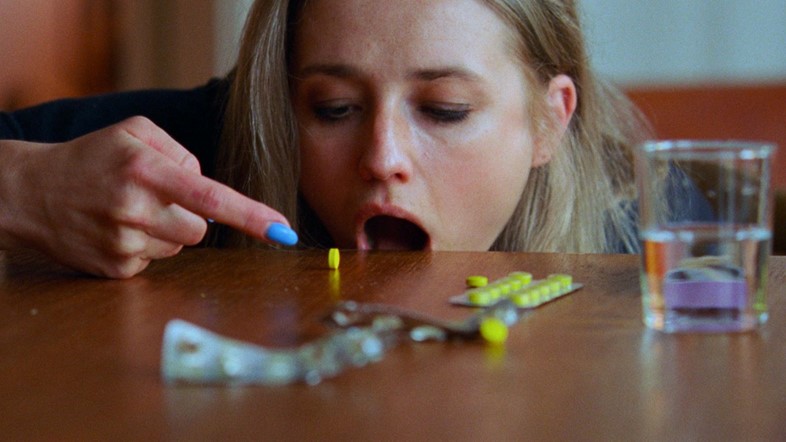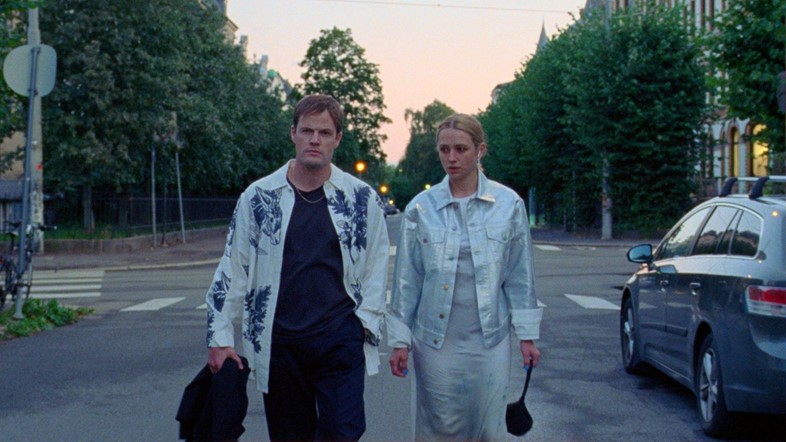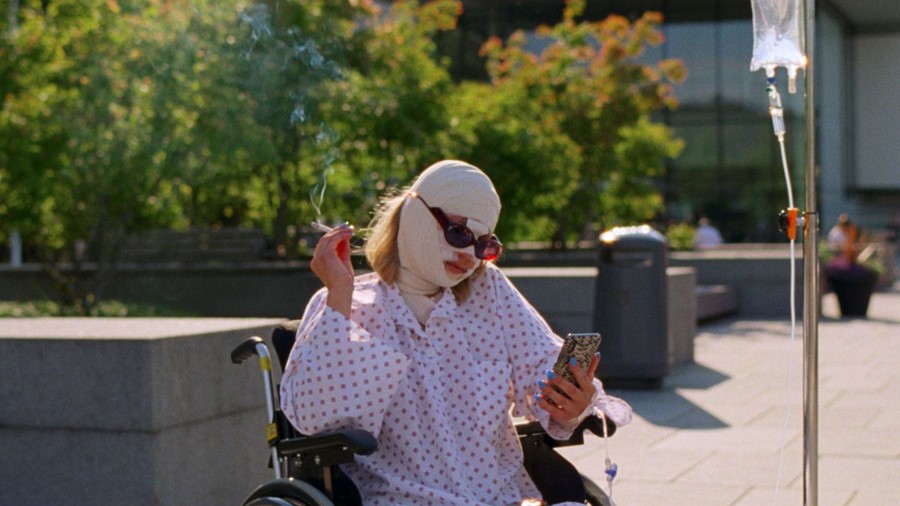Set in Oslo’s art world, Sick of Myself is a ferociously funny takedown of victim culture, snobbish art and sanctimonious fashion. Here, Kristoffer Borgli talks about his “unhinged” film
There are echoes of Ruben Östlund’s Triangle of Sadness in the opening scene of Kristoffer Borgli’s Sick of Myself: froths of chatter and laughter, as the camera follows what turns out to be a $2,300 bottle of wine, eventually settling on the faces of a couple, sat opposite each other at a high-end restaurant. Except this time, we’re not offered a glimpse into the inner lives of the uber-rich, but those who thieve their way into a glittering – and yet flimsily superficial – Oslo art world.
Signe (Kristine Kujath Thorp) and Thomas (Eirik Sæther in his acting debut) make a dash with the wine for the sole purpose of gloating about it at a party later. It’s part of a pattern for the couple, who are a perfect match in terms of their outrageous egocentrism. Thomas, who relies entirely on pinching designer furniture for his day job as a sculptor, is on the brink of his big break when an art magazine asks him to be their cover star – but Signe is unable to bear him being the centre of attention.
Clawing back the spotlight with her blue-painted nails, Signe discovers a dubious Russian drug online – rumoured to cause an unknown skin disease – and orders her own supply. In a splinter-sharp, ferociously funny takedown of victim culture, snobbish art and sanctimonious fashion – with a dash of body horror – a newly sick Signe lands herself a gig as a model for a campaign titled ‘Regardless’.
“I had two ideas in my head,” says director Borgli. “One was about a girl who somehow used a horrific skin disease to get into modelling. Then there was this other thing inspired by stories I’d heard in Oslo about an art scene with people who were stealing expensive designer furniture and expensive wines, and sometimes even putting them in galleries. Then suddenly I saw sickness in Norwegian art history, how sick girls have been a recurring subject.” The Norwegian title, Syk Pike (The Sick Girl), is shared by a Christian Krohg painting and is the name often wrongly attributed to Edvard Munch’s own painting, The Sick Child. Signe’s self-inflicted deterioration, which involves not just red blotches breaking out across her skin, but hair shedding into her hands and, eventually, blood spilling from her forehead, unfolds against a sleek and pristine backdrop of high art. One particularly gory scene is filmed in the Vigeland Museum, as a throng of polished marble statues looks on.
“There was something about these grey, centuries-old statues [of] well-sculpted, ideal bodies and having her in the middle of this in a shallow marketing campaign for a fashion brand who are trying to boast their inclusivity and their open-mindedness,” says Borgli. He adds that social media has transformed how illness is perceived in mainstream culture. “Now, you don’t need to be in proxy of a big artist. You have social media and all these outlets, where you can turn your illness into a story.”

Thorp expertly tackles her larger-than-life character, whose narcissism Borgli describes as “extremely alien to Norwegian society”, where “you’re supposed to stay in line, and not think of yourself as better as anyone else”. Sæther, meanwhile, is a professional artist who felt right at home in his role. “Eirik is an old friend of mine and was kind of the placeholder in my head when I was envisioning the script. When it came time to cast the movie, he really wanted to audition. Because I didn’t think of him as an actor, he was more the inspiration for the character – but seeing him in that first audition, he knocked it out of the park. He knows the granular textures in the art scene, knows how to speak it and behave it.” Sæther also dabbled in writing, coming up with his own dinner-party speech satirising the arrogance of artists, cut short in the film when Signe feigns a nut allergy.
Even the makeup manifesting Signe’s disease became an artistic venture, an extensive project for which Borgli drew inspiration from exotic plants and nature – but he needed to find the perfect partner to bring his vision to life. “I was looking in Scandinavia and couldn’t find the right fit,” says Borgli. “It wasn’t until I met Izzi Galindo, a New York-based prosthetics designer, that I felt a real kinship and like we were very creatively synchronised.”
Despite Signe’s detestable selfishness, there are many aspects of her personality which feel symptomatic of today’s society – and, with her spectacularly failing bids for attention, we often empathise. “It was tendencies I saw in the culture, it was my own personal negative traits or thoughts and impulses that I try to stop within myself – I let those all culminate to make this unhinged, unfiltered version of things I could recognise in myself, in people around me and the culture that I saw,” says Borgli. “In a way, Signe’s plan is sort of brilliant. She understands the mechanism of our current moment – it’s just like, you have to be really stupid to go through with it.”

One question which the film does leave largely untouched is that of mental health and self-harm, and the level of responsibility of those inadvertently wounding loved ones. At one point, Signe even flees hospital, imagining that the doctor will diagnose her with a “bad personality” and “not [being] the coolest person at parties”. “That’s a huge debate and I don’t think the movie tries to solve it,” says Borgli. “I certainly am not equipped to solve it. I do have sympathy for people who keep being drawn to things that hurt people around them, and ultimately themselves, but I still think that we need responsibility in the social contract with others.”
Themes of marketing, capitalism and its co-opting of wokeness were also wrestled with by Borgli in his debut feature Drib, a documentary-fiction fable about a comedian who gets into seemingly real-life brawls for viral videos before being scouted by an international brand. “The road to hell is paved with good intentions,” the director says. “Because [inclusivity] is a sensitive subject, it feels harder to debate it and harder to properly critique people who are sanctimonious and doing it for opportunistic or capitalistic reasons, but also thus more important.”
Looking ahead to his next project, Dream Scenario – which will star Nicolas Cage – Borgli warns he may have ammunition left in these themes yet: “If there have been themes or overlap with the work I’ve done so far, it’s because I kept trying to perfect them.”
Sick of Myself is out in UK cinemas on April 21.
